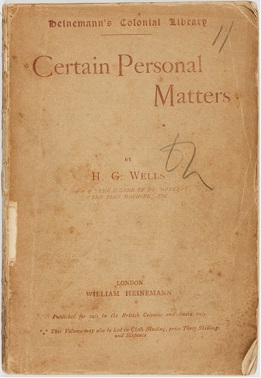Certain Personal Matters is a collection of 39 mainly humorous essays and articles written by the English author H. G. Wells (1866–1946), first published by William Heinemann in 1897.[1] The essays are written from a consistent first-person perspective, but only one describes an identifiable event in Wells’s life – how he responded to being diagnosed with tuberculosis in late 1887. For the others, the author adopts the playful persona of an aspiring young writer living in modest circumstances with a wife, Euphemia, who is only sketchily and obliquely described.
The tone of the essays reflects the demands of the market in London magazines for “short essays, or short stories, often with a twist, which can be read in half a dozen minutes, but which will pique a reader’s attention and ultimately allow him to think, ‘How true. I have done that myself’, or to make some similar remark.”[2] Half a dozen of them deal with scientific themes, especially natural selection and evolution, and in “The Extinction of ManPessimistic essay by H. G. Wells first published in 1894, about some of the ways humanity could become extinct.” Wells shows that he is contemplating themes that would be elaborated on in his next novel, The War of the Worlds: “Even now, for all we can tell, the coming terror may be crouching for its spring and the fall of humanity may be at hand.”
Composition
The essays in Certain Personal Matters rely on stock characters that Wells developed in his early days as a writer. This vein was inspired by his reading of When a Man’s Single, an 1888 novel by J. M. Barrie, in which a character explains that saleable articles can be devised from everyday things like pipes, umbrellas, and flower pots.[3] According to biographer David C. Smith, one character is “probably based on his father (and perhaps partly on his older brothers), another based on his mother apparently (although the character is always referred to as an ‘aunt’, which may be somewhat symbolic), and a third character, ‘Euphemia’. This last is usually thought to be a portrait of Jane [Catherine] Wells, though the figure may have some traits of Isabel [Wells’s cousin and first wife] as well.”[2]
Contents
Essays are shown in the order in which they appear in the book, which is not necessarily the order in which they first appeared in print elsewhere.
- “Thoughts on Cheapness and My Aunt Charlotte”
- “The Trouble of Life”
- “On the Choice of a WifeEssay by H. G. Wells first published in 1895, offering advice to young men on choosing a wife.“
- “The House of Di Sorno: A Manuscript Found in a Box”
- “Of Conversation: An Apology”
- “In a Literary Household”
- “On Schooling and the Phases of Mr. Sandsome”
- “The Poet and the Emporium”
- “The Language of Flowers”
- “The Literary Regimen”
- “House-Hunting as an Outdoor Amusement”
- “Of Blades and Bladery”
- “Of Cleverness: Apropos of One Crichton”
- “The Pose Novel”
- “The Veteran Cricketer”
- “Concerning a Certain Lady”
- “The ShopmanEssay by H. G. Wells published in 1894, about a visit to a draper's shop and an infuriating shop assistant.“
- “The Book of CursesEssay by H. G. Wells first published in 1894, about Professor Gargoyle's regret for the decline in swearing.“
- “Dunstone’s Dear Lady”
- “Euphemia’s New Entertainment”
- “For Freedom of Spelling: The Discovery of an Art”
- “Incidental Thoughts on a Bald HeadEssay by H. G. Wells first published in 1895, about the replacement of natural losses such as hair and teeth with artificial substitutes.“
- “Of a Book UnwrittenSatirical essay by H. G. Wells first published in 1893, about the evolution of human beings into a form resembling a human foetus.“
- “The Extinction of ManPessimistic essay by H. G. Wells first published in 1894, about some of the ways humanity could become extinct.“
- “The Writing of Essays”
- “The Parkes Museum”
- “Bleak March in Epping Forest”
- “The Theory of Quotation”
- “On the Art of Staying at the Seaside: A Meditation at Eastbourne”
- “Concerning Chess”
- “The Coal-Scuttle: A Study in Domestic Aesthetics”
- “Bagarrow”
- “The Book of Essays Dedicatory”
- “Through a Microscope: Some Moral Reflections”
- “The Pleasure of Quarreling”
- “The Amateur Nature Lover”
- “From an Observatory”
- “The Mode in Monuments: Stray Thoughts in Highgate Cemetery”
- “How I Died”
See also
- H. G. Wells bibliographyList of publications written by H. G. Wells during the more than fifty years of his literary career.
External links
- Certain Personal Matters at Project Gutenberg
This article may contain text from Wikipedia, released under the Creative Commons Attribution-ShareAlike License.

